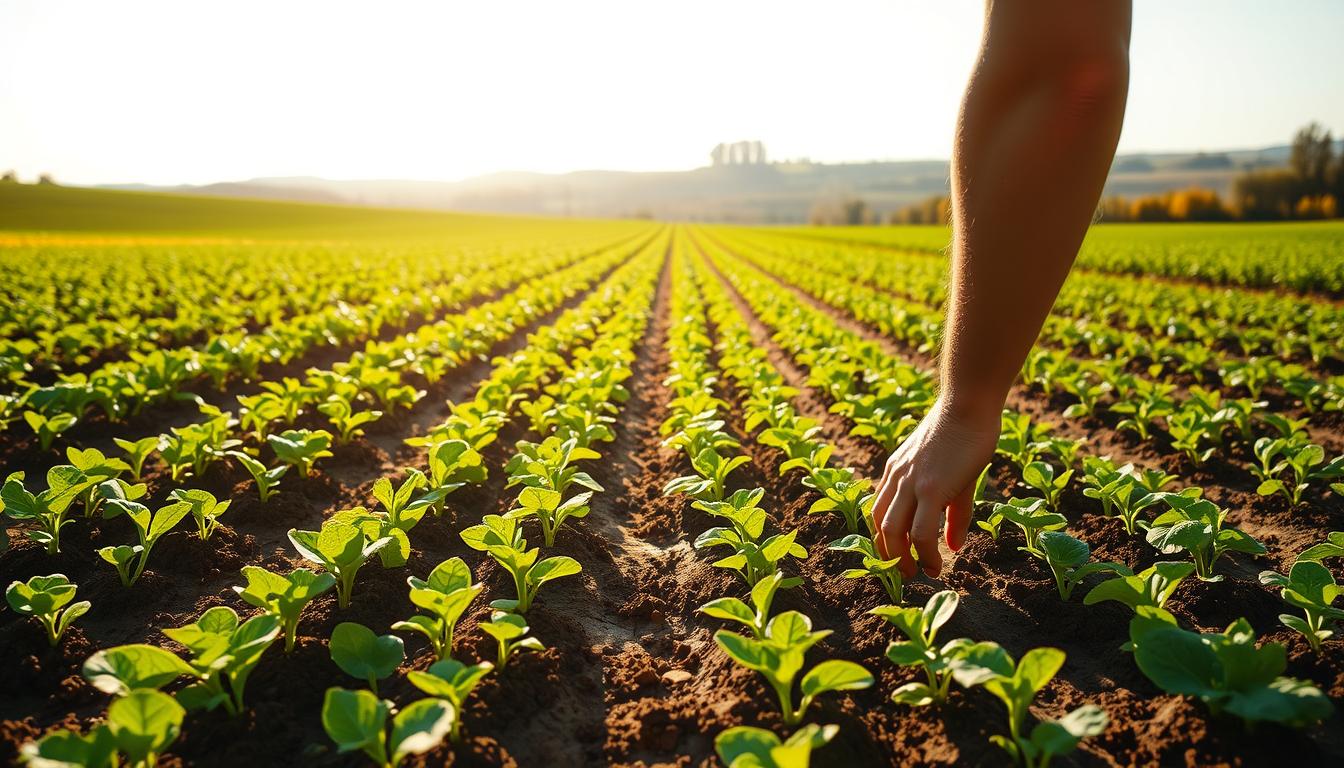Planning your garden? Ever thought about the best time to plant? The right planting time can greatly affect your harvest’s quality and yield. Crop planting dates change based on temperature, daylight, and where you live. A planting calendar can guide you to the best planting times.
Knowing the ideal planting times lets you align with nature’s cycles for a better harvest. Each crop has its own needs, like soil temperature and moisture. Whether it’s cool-season veggies like spinach or warm-season crops like tomatoes, knowing when to plant is key. A planting calendar helps you stay on schedule and plant at the perfect time for your area.

Introduction to Optimal Planting Time
Planting at the right time is crucial for a successful garden. With the right planting dates and a well-planned calendar, you can enjoy a rich harvest. The best planting time varies by location, crop type, and growing conditions. By considering these and making a personalized calendar, you can plant at the best time for your crops.
Key Considerations for Crop Planting
When picking planting dates, several factors are important. You need to know each crop’s needs, plan with a calendar, and think about soil temperature and moisture. By keeping these in mind, you can plant at the best time and help your crops thrive.
Table of Contents
Understanding the Importance of Crop Planting Dates
When planning your agricultural planting schedule, it’s key to know the best time to plant crops. The timing of planting greatly affects crop growth, yield, and resistance to pests and diseases. Plants need the right temperature, sunlight, and weather to thrive.
The best planting schedule considers the planting window and storage capacity. This helps reduce food wastage during harvesting. Knowing the factors that influence planting dates helps make informed decisions. These include climate, soil temperature, and moisture levels.
Research shows that planting crops within a specific time window can increase yields. For example, maize planted in South Africa between October and mid-December yields more than those planted later. Understanding the importance of timing can help you plan better and increase yields.
Why Timing Matters in Agriculture
Timing is crucial in agriculture because it affects crop growth stages. Crops need specific heat, soil moisture, and location to grow well. Planting at the right time ensures they get the best conditions.
Factors Influencing Planting Dates
Several factors affect planting dates, including climate, soil temperature, and moisture levels. Knowing these factors helps plan an effective planting schedule. For instance, the best planting dates for maize in South Africa are from October to mid-December. In other regions, the dates may differ.

Climate Zones Across the United States
When you’re getting ready for the planting season, knowing your climate zone is key. The U.S. has thirteen climate zones, each with its own special features. You can find your zone using the USDA Plant Hardiness Zone Map, which uses data from 13,412 weather stations. This map is a great planting season guide for picking the right plants for your area.
The climate zones affect when you should plant different crops. For instance, places with mild winters can garden all year. But areas with cold winters have a shorter growing season. Knowing your climate zone helps you decide when to plant, what to plant, and how to take care of your plants.
Important things to think about when figuring out your climate zone include:
- Average annual temperature
- Coldest winter temperature
- Length of the growing season
By looking at these factors and the USDA Plant Hardiness Zone Map, you can make a planting season guide just for your climate zone.
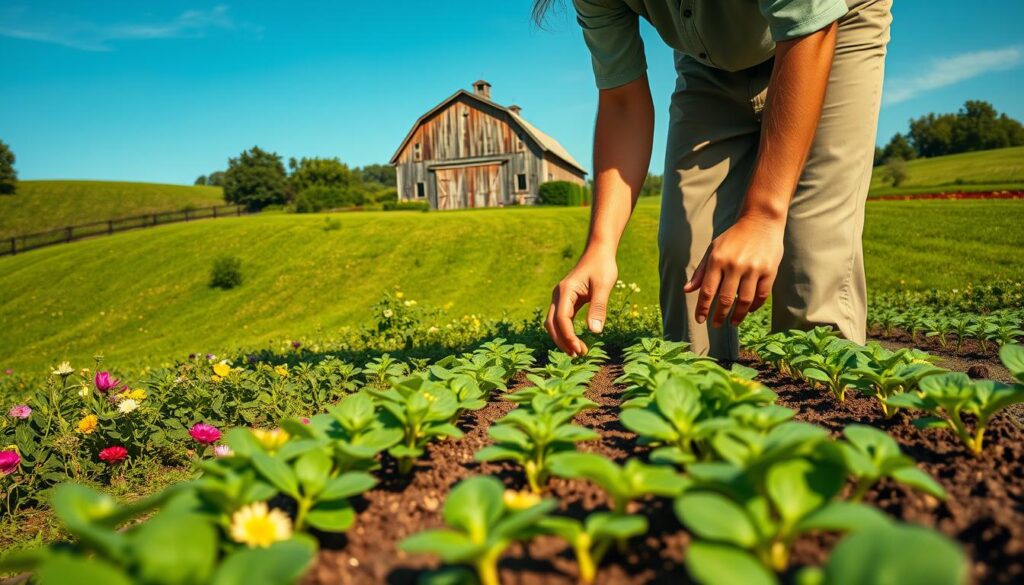
Regional Crop Planting Dates Overview
Understanding crop planting dates by region is key for a good harvest. Each area has its own challenges and chances. The United States is split into several regions, each with its own needs.
In the Northeast, Midwest, Southern, and Western regions, planting dates vary a lot. For example, in Kansas and Nebraska, corn planting ends on May 25. But in Illinois, Indiana, Ohio, and Michigan, it’s June 5. These differences come from climate, soil temperature, and frost dates.
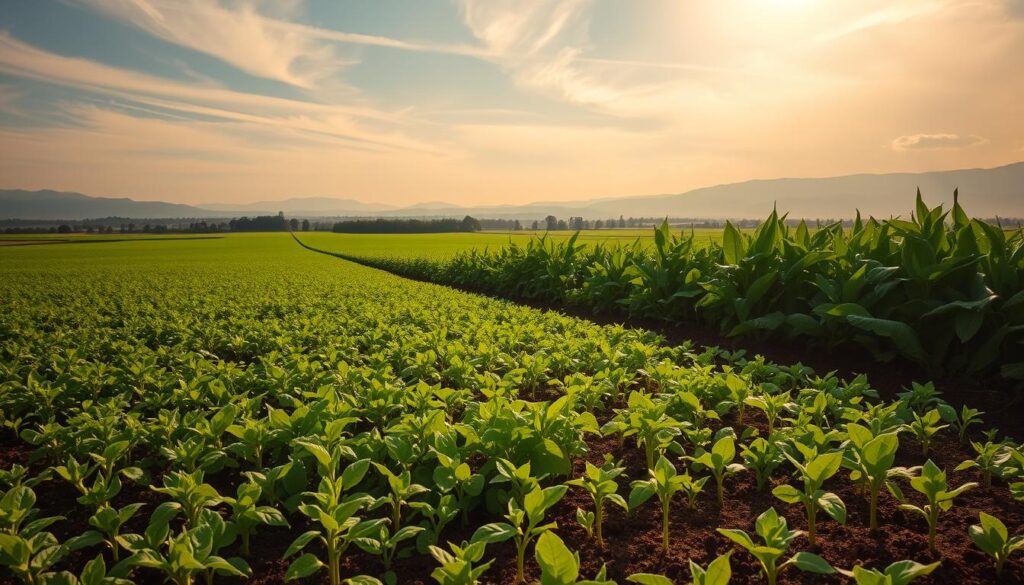
To succeed with your planting calendar, know the specific dates for your area. Here are some important points to remember:
- The insurance guarantee for corn drops by 1% each day for the next 20-25 days after the final planting date.
- Corn planted on May 15 can yield 95 to 98% of the yield of corn planted in late April under ideal soil conditions.
- Soybean yield decreases by 0.1 to 0.2% per day when planting is delayed from late-April to May.
By considering these factors and making a personalized planting calendar, you can improve your chances of a successful harvest. Always keep up with the latest research and data to make informed decisions for your region.
Optimal Planting Dates for Common Crops
Figuring out the best time to plant crops is key. The planting schedule changes based on the crop type, climate, and area. It’s vital to plant at the right time, considering soil temperature and moisture.
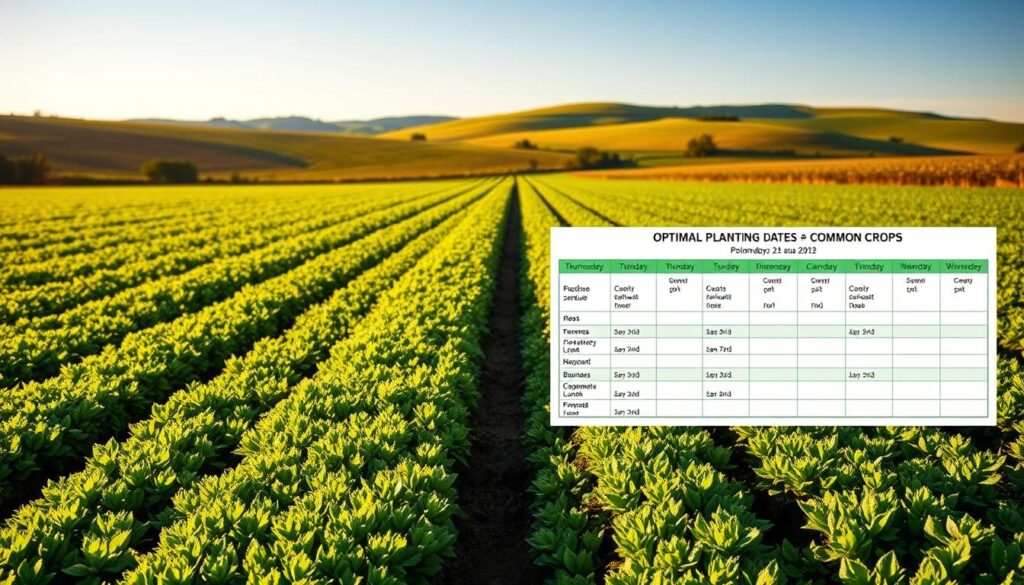
For example, corn planting starts in late April to early May. This is when soil temperatures hit 50°F at 2 inches deep. Soybeans, on the other hand, go in when soil temperatures reach 55°F, a bit later than corn.
Here are some important dates for common crops:
- Corn: late April to early May
- Soybeans: a few weeks after corn
- Spring wheat: as early as possible when soil is around 35°F
- Cotton: when soil temperatures are at least 60°F
- Peanuts: when soil temperatures stay at least 65°F
By following these planting dates, you can make a good planting schedule. Always check each crop’s specific needs and adjust your plan as needed.
The Role of Soil Temperature and Moisture
Creating a planting calendar means knowing when to plant. Soil temperature and moisture are key. For example, lettuce and spinach need soil around 60°F (15.5°C) to grow. But warm-weather crops like tomatoes need soil closer to 70°F (24°C).
To find the best planting time, check soil moisture and temperature. Use a thermometer to measure soil temperature 2 to 4 inches deep. Also, make sure the air temperature at night is over 50°F (10°C) for warm-weather plants. Daytime should be about 75°F (24°C) for the best growth.
Soil type matters too. Sandy soils heat up fast, which can harm seeds and roots. But cooler, wetter soils take longer to warm, affecting early spring planting. Knowing these details helps you plan the best planting times for your crops and soil, leading to a successful harvest.
Utilizing Planting Calendars
To get the most out of your planting season guide, it’s key to know how to use planting calendars. A planting calendar helps you plan and organize your planting dates. It ensures you use your growing season well. You can tailor it to your needs by considering climate, soil temperature, and moisture.
Here’s how to make your own planting calendar:
- Find your USDA hardiness zone to know the best crop planting dates for you.
- Look up what each crop needs to grow well.
- Plan your planting based on your area’s last spring and first fall frost dates.
Online tools like interactive maps and gardening apps offer great info on planting season guide. They help you find the perfect planting dates for your area. By using these tools and making a custom planting calendar, you can improve your crop yields and enjoy your growing season more.
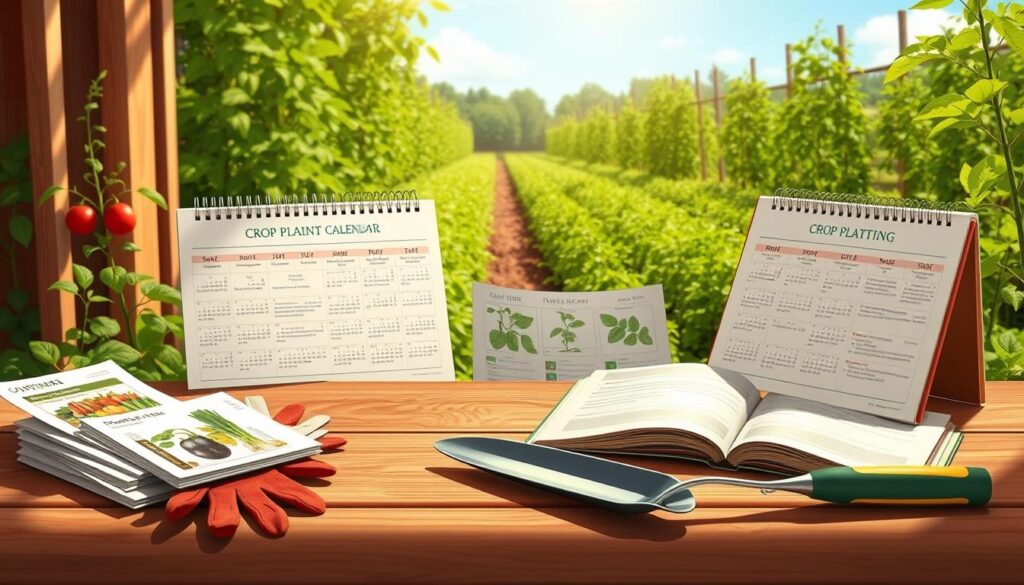
Tips for Adjusting Planting Dates
When you plan your planting schedule, think about the best time to plant in your area. Knowing the weather and adjusting your planting dates can really help your crops grow well. Understanding the best conditions for planting helps you decide when to start seeds indoors or move them outside.
When you adjust your planting dates, think about temperature, rain, and soil moisture. For example, tomatoes need soil that’s at least 55°F (13°C) to grow well. But broccoli and kale do better in cooler weather and can be planted early in spring.
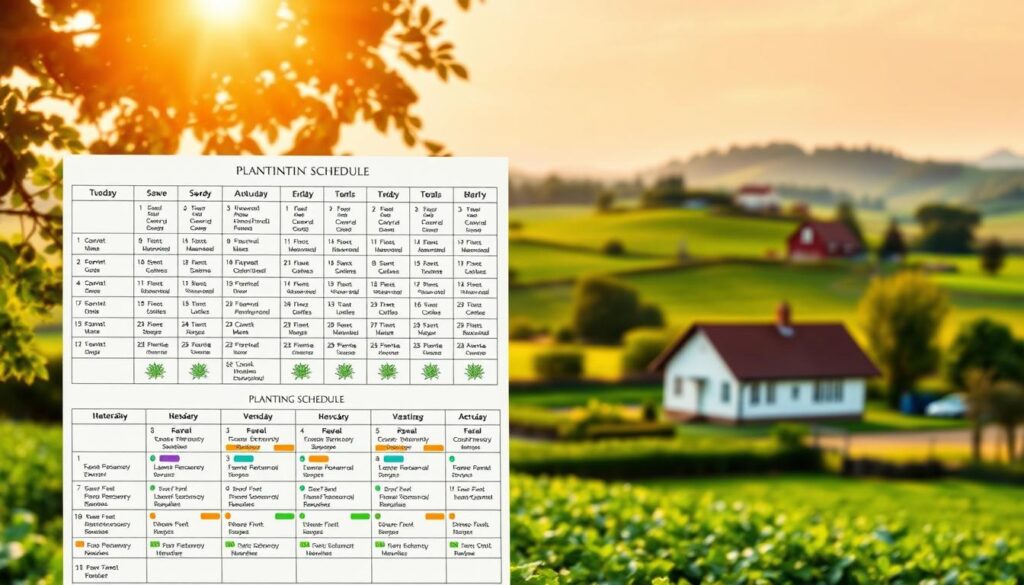
- Start seeds indoors 4-6 weeks before the last frost date to get a head start on the growing season
- Transplant seedlings outdoors when the weather is favorable, taking care not to shock the plants
- Use row covers or other protective measures to extend the growing season and protect crops from extreme weather conditions
By following these tips and watching the weather, you can make a great planting schedule. This will help you use your growing season well and plant at the best time for your area.
Tools and Technologies for Predicting Planting Dates
When planning your crop planting, the right tools and technologies are crucial. A planting calendar is a great tool that shows the best planting times for your area. It considers climate, soil temperature, and moisture levels to help your crops thrive.
Datasets like Farming the Planet 2 (FTP2) and the Crop Calendar Dataset (CCD) give insights into planting and harvest times. These can guide your planting calendar. Weather apps and forecasting tools also offer current weather and soil conditions, helping you adjust your planting plan.
Some key tools for predicting planting dates include:
- Weather apps and forecasting tools
- Soil moisture sensors
- Crop calendars and planting schedules
- Remote sensing and satellite imagery
Using these tools, you can make a detailed planting calendar for your farm or garden. This ensures your planting schedule is optimized for the best crop outcomes.
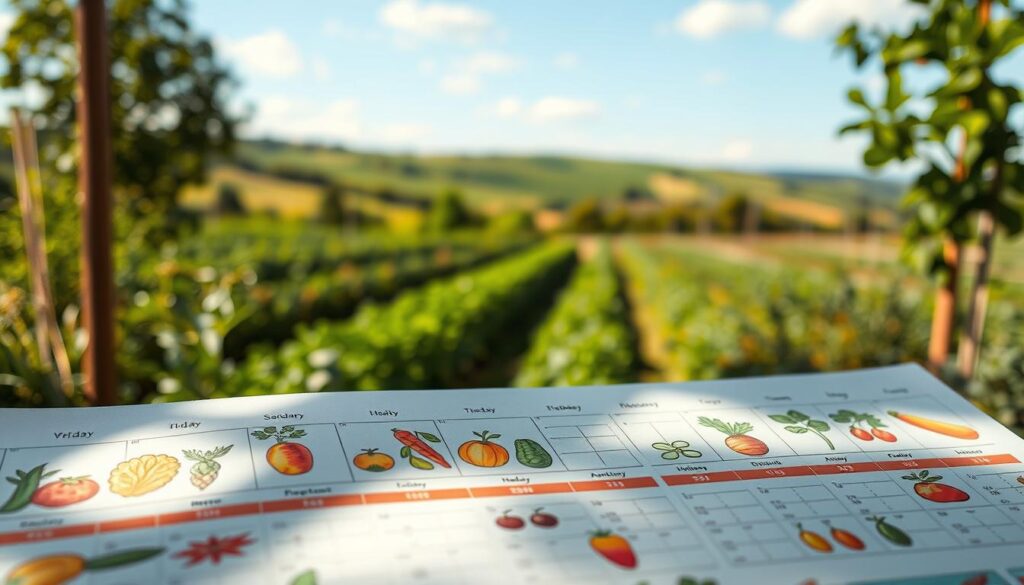
Staying informed and adapting to changes is key for successful crop planting. With the right tools, you can make smart decisions and create a planting calendar that meets your goals.
The Impact of Climate Change on Planting Dates
When planning your crop planting dates, remember the effects of climate change. Rising temperatures and changing weather patterns can alter the best planting times for different crops. In the U.S., the growing season air temperature is expected to rise by 1.5 to 3.5° F in the coming decades. This change can push planting dates earlier or later.
The link between crop growth and temperature is clear. Knowing the ideal temperature ranges for each crop is key. For example, corn yields can drop if it’s too hot during its growth phase. Soybeans also suffer if it gets too hot during their growth phase. A planting season guide that considers these temperature needs can help farmers choose the right planting times.
Some important facts to keep in mind when adjusting your planting dates include:
- Projected decline in global maize yields by approximately 6% in the lowest warming scenario
- Potential decline in European maize yields by up to 20% due to rising temperatures
- Expected decline in wheat yields by 6.6% without carbon fertilization at 2°C of warming
It’s crucial to adjust to changing weather and plan for the long term to fight climate change’s impact on crops. By understanding climate change’s effects on planting dates and using a reliable guide, you can make better choices. This will help you get the most out of your crops.
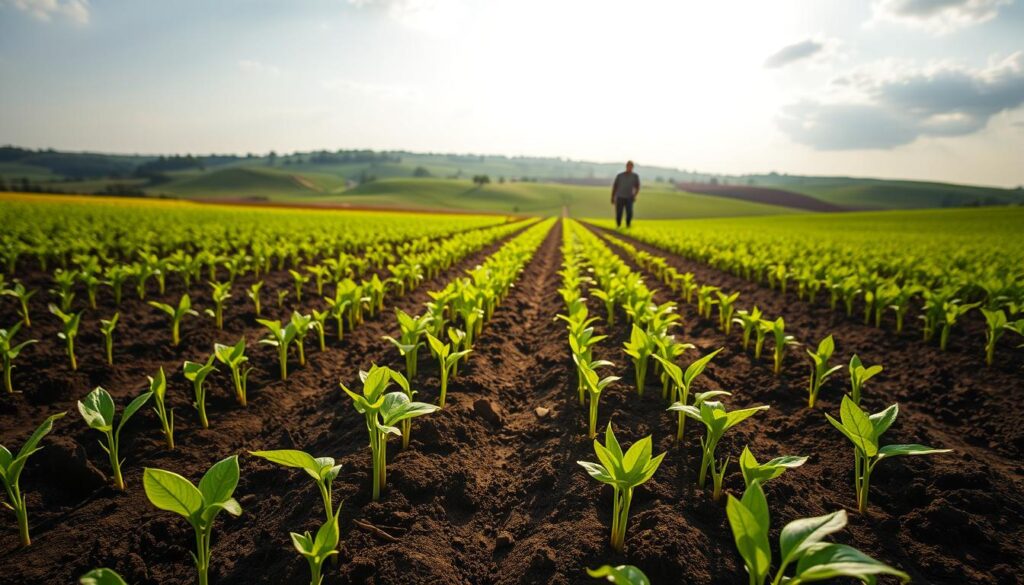
Common Planting Date Mistakes to Avoid
Knowing the best time to plant crops is key for a good harvest. Many gardeners and farmers make mistakes that hurt their yields. One big mistake is not considering local conditions like climate and soil type.
Another error is not following crop success tips. For example, seeds usually germinate in 2 weeks at 70 to 80 degrees Fahrenheit. Planting them at the right depth, no deeper than a quarter-inch, is crucial for germination.
To avoid these mistakes, make a planting schedule for your area. Think about the last frost date, soil pH, and sunlight for your plants. By planning carefully, you can plant at the best time and get a great harvest.
Final Thoughts on Successful Crop Planting
Starting your gardening or farming journey? Remember, building local knowledge is crucial. It helps you make the most of your planting calendar and find the best time to plant. Pay attention to your area’s unique climate and soil. Also, watch the weather, as it can change your growing season.
Use your local resources wisely and adjust your planting plans. This will lead to a great harvest. Be flexible and try succession planting. Use tools like row covers or greenhouses to grow longer. With the right strategy, your crops will flourish, and you’ll enjoy your harvest all year.
FAQ
What is the importance of understanding crop planting dates?
Planting at the right time can greatly improve crop yield and quality. Knowing when to plant can help you make the most of the growing season.
What factors influence crop planting dates?
Climate, soil temperature, and moisture levels are key factors. They all play a role in determining the best planting times for different crops.
How can I identify my local climate zone?
Knowing your climate zone is crucial. It helps you figure out the best planting times for your area. This way, you can plan your growing season effectively.
What are the best planting dates for common crops in my region?
The article covers planting times for various regions. It includes the Northeast, Midwest, South, and West. It focuses on vegetables, fruits, and grains.
How important is soil temperature and moisture for crop planting?
Soil temperature and moisture are very important. The article explains how to check these factors. It helps ensure your crops grow well.
How can I create a personalized planting calendar?
The article shows you how to make a planting calendar for your area. It also mentions online tools to help find the best planting dates.
How can I adjust my planting dates in response to weather patterns?
The article talks about adapting to weather changes. It offers tips for adjusting planting schedules. This ensures your crops thrive, even with unexpected weather.
What tools and technologies can help me determine the optimal planting dates?
The article looks at using weather apps and soil sensors. These tools help predict the best planting times. They aid in making informed planting decisions.
How is climate change affecting crop planting dates, and what can I do about it?
Climate change is changing planting dates. The article discusses adapting to these changes. It offers strategies for farmers to cope with climate shifts.
What are some common mistakes to avoid when it comes to planting dates?
The article warns against ignoring local conditions. It stresses the need to follow planting advice for success. It highlights mistakes that can lead to poor yields.
Source Links
- Seasonal Sowing Guide: Best Times for Vegetable Gardening – https://bokashiearthworks.net/seasonal-sowing-the-right-times-to-plant-your-vegetable-garden/
- Understanding When to Plant Vegetables – https://www.almanac.com/understanding-when-plant-vegetables
- Planting Calendar: When to Plant These Popular Vegetables – https://www.familyhandyman.com/article/when-to-plant-garden-calendar/?srsltid=AfmBOoo3jitnBhv_SLQ5AmtHF-A33ZPag9ZeRAqxJ28UpzOBBNW_Ckk6
- Optimizing Crop Planting Schedule Considering Planting Window and Storage Capacity – https://pmc.ncbi.nlm.nih.gov/articles/PMC8924502/
- Frontiers | Optimizing Crop Planting Schedule Considering Planting Window and Storage Capacity – https://www.frontiersin.org/journals/plant-science/articles/10.3389/fpls.2022.762446/full
- Effects of planting date, environments and their interaction on grain yield and quality traits of maize hybrids – https://pmc.ncbi.nlm.nih.gov/articles/PMC10660031/
- What Planting Zone Do I Live In? Updated USDA Plant Hardiness Map – https://www.almanac.com/what-are-plant-hardiness-zones
- Climate change is shifting plant growth zones. Here’s what to know for your garden this year – https://www.pbs.org/newshour/science/climate-change-is-shifting-plant-growth-zones-heres-what-to-know-for-your-garden-this-year
- Master Your Garden with USDA Hardiness Zones – Baxter Gardens – https://baxtergardens.com/blog/guide-to-usda-hardiness-zone-map-for-gardens
- Corn Hitting Final Planting Dates – https://greatamericancrop.com/news-resources/article/2024/05/31/corn-hitting-final-planting-dates
- Field Notes: Corn and soybean planting – Are we on schedule? – https://blog-crop-news.extension.umn.edu/2024/05/field-notes-corn-and-soybean-planting.html
- Maximize Your Harvest: Optimal Planting Conditions for Common US Crops – Wearparts LLC – https://wearpartsllc.com/optimal-planting-conditions-for-common-us-crops/
- When to plant vegetables – our month-by-month guide to sowing and growing a wealth of crops – https://www.homesandgardens.com/gardens/when-to-plant-vegetables
- The Importance of Soil Temperature: A Guide to Optimal Crop Growth | Just Grow Something with Karin Velez – https://justgrowsomethingpodcast.com/blog/the-importance-of-soil-temperature-a-guide-to-optimal-crop-growth
- Using soil moisture and temperature data for optimising growth – https://agriculture.vic.gov.au/farm-management/land-and-pasture-management/using-soil-moisture-and-temperature-data
- Vegetable Planting Calendars: An Easy Zone and State Garden Guide – https://ponicslife.com/vegetable-planting-calendars-an-easy-zone-and-state-garden-guide/
- When to Start Seeds Indoors: Planting Calendars for Every Zone – https://homesteadandchill.com/when-to-start-seeds-garden-planting-calendars/?srsltid=AfmBOopmwqchhear_Fza9ewauyvwvpdK_K6468a7m6YE23CXPB0dANcx
- Spring Gardening Calendar | Gardeners.com – https://www.gardeners.com/spring-gardening-calendar?srsltid=AfmBOorAP_5RO3eW1xJnM1bvQdhMVevkoiPz06pACNJWVBdZaBE7ED1P
- When to Start Seeds Indoors: Planting Calendars for Every Zone – https://homesteadandchill.com/when-to-start-seeds-garden-planting-calendars/?srsltid=AfmBOoqa8mRDeIDhd1ng9sAiode5YFFiFkSZZllIZ8aBCAqUyCz7x3pO
- When to plant vegetables: a guide to sowing and harvesting vegetables – https://www.lovethegarden.com/uk-en/article/when-plant-vegetables-guide-sowing-and-harvesting-vegetables
- Crop Planting Dates: An Analysis of Global Patterns – https://www.dante-project.org/datasets/sage-cpd
- Considerations for planting depth this year – https://agcrops.osu.edu/newsletter/corn-newsletter/2020-09/considerations-planting-depth-year
- Corn Product Interactions with Planting Date and Seeding Depth | Crop Science US – https://www.cropscience.bayer.us/articles/dad/corn-product-interactions-with-planting-date-and-seeding-depth
- Warmer Isn’t Always Better: How Rising Temperatures Impact Crop Production – http://www.climatehubs.usda.gov/hubs/northeast/topic/warmer-isnt-always-better-how-rising-temperatures-impact-crop-production
- How will climate change affect crop yields in the future? – https://ourworldindata.org/will-climate-change-affect-crop-yields-future
- 10 seed-starting mistakes and how to avoid them – https://www.pennlive.com/gardening/2025/02/10-seed-starting-mistakes-and-how-to-avoid-them.html
- 7 Planting Mistakes That Will Spoil Seedlings & Tender Plants – https://www.gardeningknowhow.com/garden-how-to/info/planting-mistakes-that-will-spoil-seedlings-and-tender-plants
- How to Avoid 8 Common Garden Mistakes – https://www.homedepot.com/c/ai/how-to-avoid-8-common-garden-mistakes/9ba683603be9fa5395fab900c89c359
- The Right Crop, The Right Time: Seasonal Planting for Garden Success – https://gardensuperstore.com.au/insights/the-right-crop-the-right-time-seasonal-planting-for-garden-success/?srsltid=AfmBOor2ZFA_kkXPuqBXoEezwwyAcNZ0C1UJd974owhPNhy4r6rmtL5B
- Notes on soybeans as planting gets underway – farmdoc – https://farmdoc.illinois.edu/field-crop-production/notes-on-soybeans-as-planting-gets-underway.html
- Planting Cold Crops in the Fall: What to Grow and How to Harvest – Blog- Mahoney’s Garden Center – https://mahoneysgarden.com/ultimate-guide-to-planting-cold-crops-in-the-fall/

